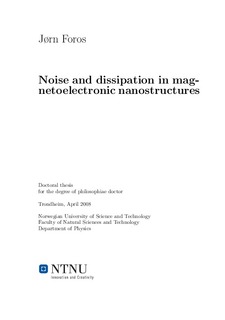| dc.contributor.advisor | Brataas, Arne | nb_NO |
| dc.contributor.author | Foros, Jørn | nb_NO |
| dc.date.accessioned | 2014-12-19T13:10:43Z | |
| dc.date.available | 2014-12-19T13:10:43Z | |
| dc.date.created | 2008-03-31 | nb_NO |
| dc.date.issued | 2008 | nb_NO |
| dc.identifier | 123910 | nb_NO |
| dc.identifier.isbn | 978-82-471-8267-3 | nb_NO |
| dc.identifier.uri | http://hdl.handle.net/11250/244468 | |
| dc.description.abstract | This thesis adresses electric and magnetic noise and dissipation in magnetoelectronic nanostructures. Charge and spin current fluctuations are studied in various nanosized metallic structures consisting of both ferromagnetic and non-magnetic elements. The interplay between current and magnetization fluctuations, and the relation of these fluctuations to the electric and magnetic dissipation of energy, are considered. Special focus is on the enhancement of magnetization damping due to so-called spin pumping, which is shown to be directly connected to thermal spin current fluctuations.
Two fundamental sources of current noise are considered: Thermal noise and shot noise. Since a spin current polarized transverse to the magnetization is absorbed in a ferromagnet, transverse spin current fluctuations exert a fluctuating torque on the magnetization. This spin-transfer torque causes significant magnetization fluctuations in nanoscale ferromagnets. In single-domain ferromagnets in contact with normal electric conductors, the spin-current induced magnetization noise is directly connected to the magnetization damping caused by spin pumping. In non-uniformly magnetized ferromagnets, the spin-current induced magnetization noise is related to a nonlocal tensor damping that reflects the spatial variation of the magnetization. At low temperatures, spin current shot noise in the presence of an applied bias is the dominant contribution to the magnetization noise.
In spin valves, two ferromagnets are separated by a thin normal metal spacer. The interaction of the ferromagnets affects their magnetization noise and damping, which are shown to vary with the relative magnetic orientation of the ferromagnets. Due to giant magnetoresistance, the magnetization fluctuations cause resistance noise. The resistance noise is identified as a prominent source of electric noise at relatively high current densities. The noise level can vary substantially with the relative magnetic orientation. | nb_NO |
| dc.language | eng | nb_NO |
| dc.publisher | Fakultet for naturvitenskap og teknologi | nb_NO |
| dc.relation.ispartofseries | Doctoral Theses at NTNU, 1503-8181; 2008:112 | nb_NO |
| dc.relation.haspart | Foros, J; Woltersdorf, G; Heinrich, B; Brataas, A. Scattering of spin current injected in Pd(001). Journal of Applied Physics. 97(10): 10A714, 2005. | nb_NO |
| dc.relation.haspart | Foros, J; Brataas, A; Bauer, G.E.W; Tserkovnyak, Y. Resistance noise in spin valves. Phys. Rev. B. 75: 092405, 2007. | nb_NO |
| dc.subject | Physics | en_GB |
| dc.subject | NATURAL SCIENCES: Physics | en_GB |
| dc.title | Noise and dissipation in magnetoelectronic nanostructures | nb_NO |
| dc.type | Doctoral thesis | nb_NO |
| dc.source.pagenumber | 92 | nb_NO |
| dc.contributor.department | Norges teknisk-naturvitenskapelige universitet, Fakultet for naturvitenskap og teknologi | nb_NO |
| dc.description.degree | PhD i fysikk | nb_NO |
| dc.description.degree | PhD in Physics | en_GB |
